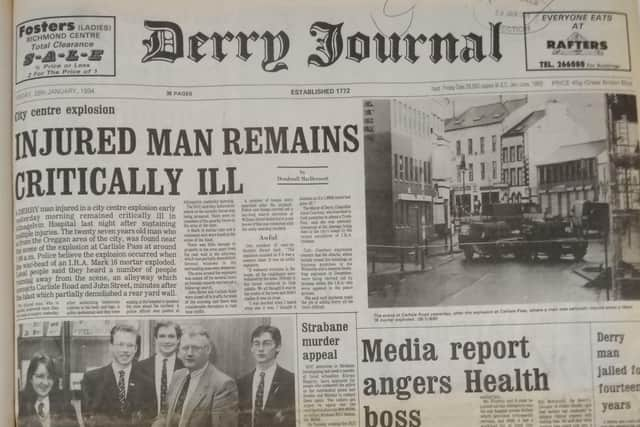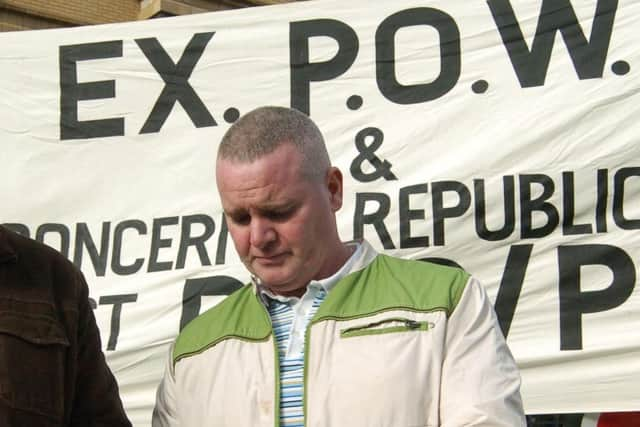Tony Taylor — a failed multiple murderer who became a republican icon and won the backing of politician and priest alike


Much was written about the effect which this detention had on Taylor and his family – however, almost nothing was written about the details of the IRA attack which saw him imprisoned in the first place.
The News Letter has tried over the last few years to obtain the original court documents from the mid-1990s dealing with this initial conviction. Now the paper has finally been granted access, and can share the details of the major crimes for which he was originally imprisoned, precisely 26 years this week since they were committed.
Advertisement
Hide AdAdvertisement
Hide AdThe court papers from 1995 (when he was convicted) and 1996 (when his appeals were rejected) run to over 13,000 words. They reveal not only that Taylor had been trying to murder multiple people when he blew himself up, but also show his case was beset by claims of intimidation against an innocent man who had come to Taylor’s aid.


Taylor’s trial had heard that on January 27, 1994, a Mark 16 mortar was being prepared when it detonated prematurely at 7am at Carlisle Pass, a pedestrian walkway just to the south of Londonderry city centre.
The court papers say the device “was to be fired at a security forces vehicle travelling along John Street, with the intention of murdering and maiming the occupants”.
Taylor was involved in setting it up, but the court could not rule out the possibility that a second, unidentified man was also present too.
Advertisement
Hide AdAdvertisement
Hide AdIn any case, prosecutors said those responsible “had made the elementary mistake of setting the safety switch and the explosive switch in the ‘on’ position before commencing to connect up the wiring” – so as soon as the command wire was attached to the battery the warhead blew up in their face.


A man – known only as Witness A – heard the blast and saw Taylor stumbling around. He initially thought Taylor was drunk.
Taylor staggered to a nearby bench where he sat down and took off a pair of thick, clear surgical gloves he was wearing. He had wounds to his legs and abdomen, and was bleeding and mumbling.
The witness went over to Taylor and asked if he was alright. Then he rushed to a phone box and called 999, and stayed with him until the emergency services arrived.
Advertisement
Hide AdAdvertisement
Hide AdWhen police came, the witness pointed out that Taylor had thrown his gloves onto the ground nearby.
Taylor told the authorities he had found the device by chance just before it exploded (a story the court deemed “highly unconvincing”).
At a Diplock trial in Belfast Crown Court, Judge J McCollum convicted Taylor of possession of an explosive with intent, causing an explosion, conspiracy to murder, and conspiracy to cause grievous bodily harm.
The judge considered jailing him for 25 years, but given his injuries he showed what the court papers describe as “a proper degree of mercy”, and cut it to 18 years.
Advertisement
Hide AdAdvertisement
Hide AdThe court papers also reveal the terror which was instilled in the man who came to the wounded Taylor’s side in the wake of the blast.
Witness A made a statement to police, and initially seemed calm and was happy to attend court. But once the trial got under way at Crumlin Road courthouse, the witness failed to show up.
Police traced him to Donegal where he told them he was never going to return to Northern Ireland.
An account of the meeting said that the witness appeared very shaken, had sweaty hands, and was smoking heavily. He told police he was “terrified” for his life and believed “the IRA were aware of his identity, as he had been approached shortly after the incident by people whom he believed to be the IRA”.
Advertisement
Hide AdAdvertisement
Hide AdHe “was receiving medical treatment for a condition directly related to his fear”.
Nevertheless, the witness was persuaded to meet again 10 days later – this time not just with police, but with Taylor’s lawyer too.
At that meeting, also held in Donegal, the witness changed his position radically.
In a low voice and with a hanging head, the witness claimed he was not in fact afraid, said no-one had threatened him, and declared he was now uncertain about what he had said in his original statement, before ending the interview abruptly and hurrying off.
Advertisement
Hide AdAdvertisement
Hide AdAfter Taylor was jailed in 1995 he appealed against both his conviction and the length of his sentence, but a year later Lord Justice Carswell threw out his appeals.
The court papers setting out details of this rejection state that a judge had been left in “no doubt that [Witness A] was afraid to give evidence because some person or persons had put him in fear” (though there is no indication Taylor himself or his defence team had any involvement in this).
In the end though, Taylor only ever served a few years; he was released early under the Belfast Agreement.
Despite this he became re-involved with paramilitarism. He was returned to prison in August 2011 accused of possessing a rifle.
Advertisement
Hide AdAdvertisement
Hide AdIn 2014 he pleaded guilty and was sentenced to three years in custody and four on licence. However by that stage he had already been in jail for almost three years, and so was soon free again.
In March 2016 Taylor – who was then aged 48 and was a member of dissident group the Republican Network for Unity – had his licence revoked by Secretary of State Theresa Villiers.
The Northern Ireland Office did not publicly state the reasons for returning him to jail, but said: “The Secretary of State’s priority must be the protection of the public; it would be irresponsible to fail to act on information indicating that they are at risk of serious harm...
“Mr Taylor is aware of the reasons for his revocation, as immediately he was returned to custody he was provided with a copy of the independent Parole Commissioner’s recommendation and the reasons why his licence was revoked.”
Advertisement
Hide AdAdvertisement
Hide AdWhat then followed were years of increasing pleas from everyone from Sinn Fein members and TDs in the Republic to SDLP leader Colum Eastwood and priest Paddy O’Kane, voicing deep disquiet over his imprisonment.
Many claimed Taylor’s return to jail amounted to “internment”. Mr Eastwood said “authorities have provided no credible evidence to support Mr Taylor’s continued detention”, while Fr O’Kane condemned “the injustice of his continued detention without charge”.
Ultimately, Taylor was released for a final time in November 2018.
The News Letter first tried to obtain Taylor’s 1995/6 court papers three years ago, as the campaign to free him was gathering pace, but the paper was rebuffed by the Department of Communities (which controls the public archive), which said the papers were exempt under the Freedom of Information Act.
Advertisement
Hide AdAdvertisement
Hide AdHowever there was a time-limit on this exemption, and when the News Letter recently re-applied to obtain the documents it was finally granted access.
The News Letter tried to reach Taylor over several days via his lawyer, via the Republican Network for Unity (which said he is no longer a member), and via Facebook.
The paper aimed to ask if he had any regrets about his paramilitary past.
No response was received.